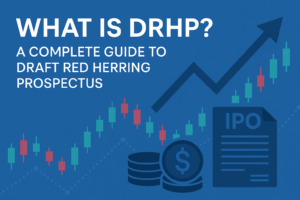IPO Process Explained: From DRHP to Listing in India
The Initial Public Offering (IPO) process is a crucial step for any company looking to raise capital and become publicly traded. This guide will walk you through the IPO process explained — from DRHP to listing — and ultimately detail every stage a company undergoes before its shares become available on the stock exchange.
What is an IPO?
An Initial Public Offering (IPO) is when a private company offers its shares to the public for the first time. This allows the company to raise capital from a broader pool of investors and enhances its credibility in the market.
Why Do Companies Go Public?
Companies decide to go public for various reasons:
- raise funds for expansion
- reduce debt
- improve brand visibility
- provide liquidity to early investors and promoters
Step-by-Step IPO Process in India
1. Appointment of IPO Intermediaries
The company appoints various intermediaries, including:
- Merchant Banker(s) – to manage the entire IPO process
- Legal Advisors – for regulatory compliance
- Auditors – to verify financials
- Registrars and Transfer Agents (RTAs) – to handle share allotment and refunds
2. Preparation of DRHP (Draft Red Herring Prospectus)
The DRHP is a preliminary document filed with SEBI (Securities and Exchange Board of India). It includes:
- Company background
- Financial statements
- Risks involved
- Use of IPO proceeds
3. Filing with SEBI
After the DRHP is prepared, it is subsequently submitted to SEBI for review, during which SEBI may seek clarifications or recommend modifications.
4. Roadshows and Investor Presentations
During this stage, the company and merchant bankers promote the IPO to institutional investors through roadshows, aiming to build investor confidence and interest.
5. Approval and RHP Filing
Once SEBI clears the DRHP, the company files the final prospectus—called the Red Herring Prospectus (RHP)—which includes the IPO price band, opening and closing dates, and updated financials.
6. Application by Investors
Investors can apply for shares via:
- UPI or ASBA-enabled bank accounts
- Online platforms like Zerodha, Groww, Upstox, etc.
Investor categories include:
- Retail Individual Investors (RIIs)
- Qualified Institutional Buyers (QIBs)
- High Net-worth Individuals (HNIs)
7. Price Discovery and Book Building
For book-built issues, investors bid within a specified price band. The final issue price is determined based on demand.
8. Allotment of Shares
After the IPO closes, shares are allotted. If oversubscribed, a lottery system is used for retail investors. Refunds are processed via bank accounts.
9. Credit of Shares to Demat Account
Allotted shares are credited to investors’ Demat accounts before the listing date.
10. Listing on Stock Exchanges
On the listing day, the company’s shares are listed on BSE and/or NSE. The listing price may differ from the issue price based on market demand and investor sentiment.
Important SEBI Regulations and Timeline
- DRHP Review: 30 days
- IPO Application Window: Typically 3-5 days
- Listing Date: Within 6 days after issue close
Pros and Cons of Investing in IPOs
Pros:
- Potential for high returns on listing day
- Opportunity to invest early in promising companies
Cons:
- Risk of overvaluation
- Volatile post-listing performance
How to Track and Analyze Upcoming IPOs
To stay updated:
- Visit NSE/BSE websites
- Follow DRHP and RHP filings on SEBI portal
- Use IPO tracking apps and platforms
Conclusion
Understanding the IPO process explained — from DRHP to listing — is essential for both investors and companies. Moreover, it ensures better decision-making, risk management, and financial planning. As a result, companies can navigate the capital markets more effectively. For investors, learning this process can help identify profitable opportunities and, conversely, avoid common pitfalls.

Share this content:








Post Comment